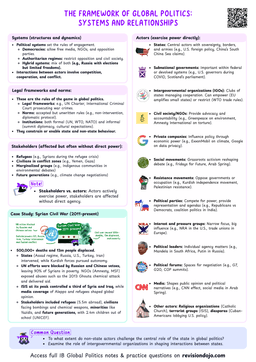Examining Unequal Power Structures
- Power asymmetries refer to imbalances in power between actors in the international system. These imbalances can occur at various levels, including:
- Global: Between powerful states (e.g., the United States) and weaker states (e.g., small island nations).
- Regional: Within regions, such as the dominance of China in East Asia.
- Local: Between governments and non-state actors, like multinational corporations or insurgent groups.

Dimensions of Power Asymmetries
1. Military Power
- Dominance of Superpowers: The United States' military presence worldwide exemplifies its ability to project power globally.
- Nuclear Capabilities: Countries like North Korea leverage nuclear weapons to counterbalance conventional military weaknesses.
- The 2003 Iraq War highlights military power asymmetries, where the US-led coalition's superior military capabilities overwhelmed Iraq's defenses.
2. Economic Power
- Control of Resources: Countries like Saudi Arabia wield influence through control of oil markets.
- Economic Sanctions: The European Union's sanctions on Russia demonstrate how economic power can be used to achieve political goals.
- China's Belt and Road Initiative illustrates economic power asymmetries, as developing countries become economically dependent on Chinese investments.
3. Political Power
- Influence in International Institutions: Permanent members of the UN Security Council (P5) have disproportionate power due to their veto rights.
- Diplomatic Leverage: The European Union's role in negotiating the Iran nuclear deal showcases its political influence.
- Power asymmetries are not static, they can shift over time due to changes in economic, military, or political conditions.
4. Cultural and Ideological Power
- Soft Power: The United States' cultural influence through media and technology.
- Normative Power: The European Union's promotion of human rights and democracy.
- The spread of Western cultural values through Hollywood films and social media platforms exemplifies cultural power asymmetries.
Causes of Power Asymmetries
- Historical Factors
- Colonial Legacies: Former colonial powers often retain economic and political influence over their former colonies.
- Cold War Dynamics: The bipolar structure of the Cold War created lasting power imbalances between the US and Soviet spheres of influence.
- Economic Disparities
- Resource Distribution: Countries with abundant natural resources often have greater economic power.
- Technological Advancements: States with advanced technology, like the United States, have a competitive edge in global markets.
- Institutional Structures
- International Organizations: The design of institutions like the IMF and World Bank often reflects the interests of powerful states.
- Trade Agreements: Bilateral and multilateral trade deals can reinforce economic dependencies.
- Geopolitical Factors
- Strategic Location: Countries in geopolitically important regions, like the Middle East, often attract external power interventions.
- Military Alliances: Membership in alliances like NATO can enhance a state's security but also create dependencies.
- Go beyond description, explain impact and power dynamics.
- Don’t just state that “the IMF reflects powerful states’ interests”. Explain how this shapes global inequalities, and evaluate with contrasting examples (e.g. how developing countries may be pressured into structural reforms).
- Use key terms like economic dependency, asymmetrical power, or neocolonialism to show depth.
- This approach demonstrates critical thinking, essential for top-band answers.
Impacts of Power Asymmetries
- Global Governance
- Inequitable Decision-Making: Power asymmetries often lead to unequal representation in international institutions.
- Dominance of Powerful States: The P5's veto power in the UN Security Council can hinder collective action.



